Aakash Repeater Courses
ApplyTake Aakash iACST and get instant scholarship on coaching programs.
Have you ever flicker a switch to turn on a light or hit a button and make a fan operational? It bases all these daily happenings on the existence of electricity- an amazing source of power that is flowing in wires and circuits to make things work around us. Electricity: Circuits and Their Components in NCERT Class 7 Science textbook goes further and explores this amazing subject, showing how electric circuitry work and why they work.
.jpg)
The NCERT solutions show the students the method of drawing circuit diagrams using standard symbols using easy-to-understand explanations using relatable examples, a basic science and engineering skill. It identifies real-life uses of electricity explaining about the topic in an interesting and very practical way. The NCERT Solutions of Class 7 Science Chapter 3 are intended to make the learning even more successful. Class 6 Science Chapter 3 solutions include answers to each in-text and exercise questions, important topics and principles to enable students to have a grasp of the science of circuits, important points and definitions that can help to revise a concept and recall it in a short period
1. Choose the incorrect statement.
(i) A switch is the source of electric current in a circuit.
(ii) A switch helps to complete or break the circuit.
(iii) A switch helps us to use electricity as per our requirement.
(iv) When the switch is in ‘OFF’ position, there is an air gap between its terminals.
Answer:
(i): This statement is wrong; a switch does not provide electric current in a circuit. The electric current supplied to a circuit is generally provided by a battery or power source. A switch simply opens and closes the circuit and therefore controls the flow of current.
(ii): This statement is right. The job of a switch is to close (or complete) and open (or break) an electrical circuit, which then allows current to flow or stops the flow of current.
(iii): This statement is right. By using switches, we have control over when and where electricity flows, and we only have to use electric devices when we actually need to do something.
(iv): This statement is right. When the switch is in the 'OFF' position, there is a break in the electrical pathway (that break is typically filled with air, which is an insulator), and therefore current cannot flow.
2. Observe Fig. 3.16. With which material connected between the ends A and B, the lamp will not glow?
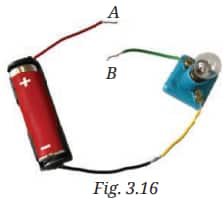
Answer:
The lamp will not glow if the material between the ends A and B is an insulator (like rubber, plastic, or wood). These materials do not allow electricity to flow through them.
3. In Fig. 3.17, if the filament of one of the lamps is broken, will the other glow? Justify your answer.

Answer:
If one lamp has a broken filament, then the other lamp will not light up, either.
- When one lamp's filament breaks, it opens a gap in the circuit.
- This gap indicates that the path for the electric current is discontinuous. When the circuit is open, the current can no longer flow through the circuit.
- Although the other lamp may be perfectly fine and operating, it will not glow because no electricity is reaching it because of the gap/disconnection.

4. A student forgot to remove the insulator covering from the connecting wires while making a circuit. If the lamp and the cell are working properly, will the lamp glow?
Answer:
The insulator stops the electric current from flowing through the wire, which is required for the lamp to glow, therefore no, it won't.
You must remove the insulation from the sections of the wire that link to the cell and the light in order for the circuit to function and the lamp to glow. The lamp will light up as a result of the power flowing through this!
5. Draw a circuit diagram for a simple torch using symbols for electric components.
Answer:
A simple torch circuit can be represented as:
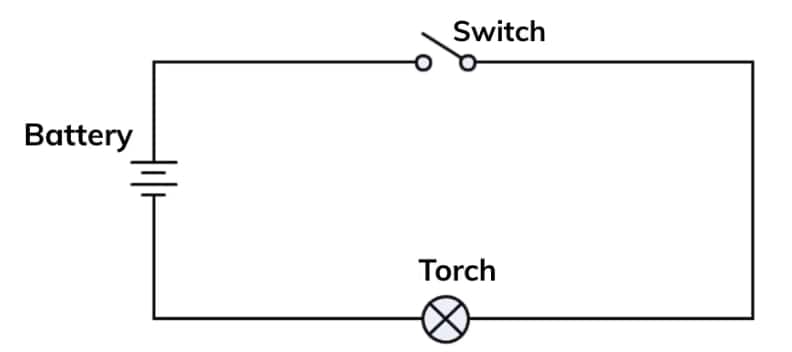
This is a simple series circuit where the battery provides power, the switch controls the current, and the lamp glows when the current flows.
6. In Fig. 3.18:
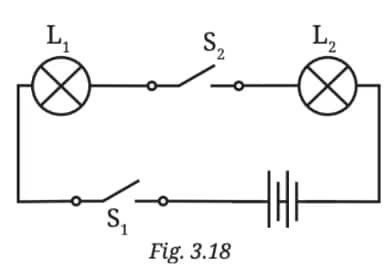
(i) If S2 is in ‘ON’ position, S1 is in ‘OFF’ position, which lamp(s) will glow?
(ii) If S2 is in ‘OFF’ position, S1 is in ‘ON’ position, which lamp(s) will glow?
(iii) If S1 and S2 both are in ‘ON’ position, which lamp(s) will glow?
(iv) If both S1 and S2 are in ‘OFF’ position, which lamp(s) will glow?
Answer:
(i) Ans: Neither lamp will glow because both switch 1 is open.
(ii) Ans: Neither lamp will glow because both switch 2 is open.
(iii) Ans: Both Lamp 1 and Lamp 2 will glow, as both switches are closed, allowing current to flow to both lamps.
(iv) Ans: Neither lamp will glow because both switches are open, preventing current flow.
7. Vidyut has made the circuit as shown in Fig. 3.19. Even after closing the circuit, the lamp does not glow. What can be the possible reasons? List as many possible reasons as you can for this faulty operation. What will you do to find out why the lamp did not glow?

Answer:
Some possible reasons are:
- The lamp has a broken filament (if it’s an incandescent lamp).
- Loose connections or poor contact in its electrical terms.
- Battery is dead(done) or battery terminals are not placed correctly.
- The wires are not properly connected to the lamp or battery.
- The circuit has an open circuit due to a faulty switch or a broken connection in the circuit.
In order to find out why the lamp did not glow, you should:
- Inspect the lamp for a broken filament.
- Make sure everything has secure connections.
- Use a simple tester to test the battery and make sure it is working.
- The switch is in the ‘ON’ position.
- Check the wiring in order to make sure there is electrical contact.
8. In Fig. 3.20, in which case(s) the lamp will not glow when the switch is closed?
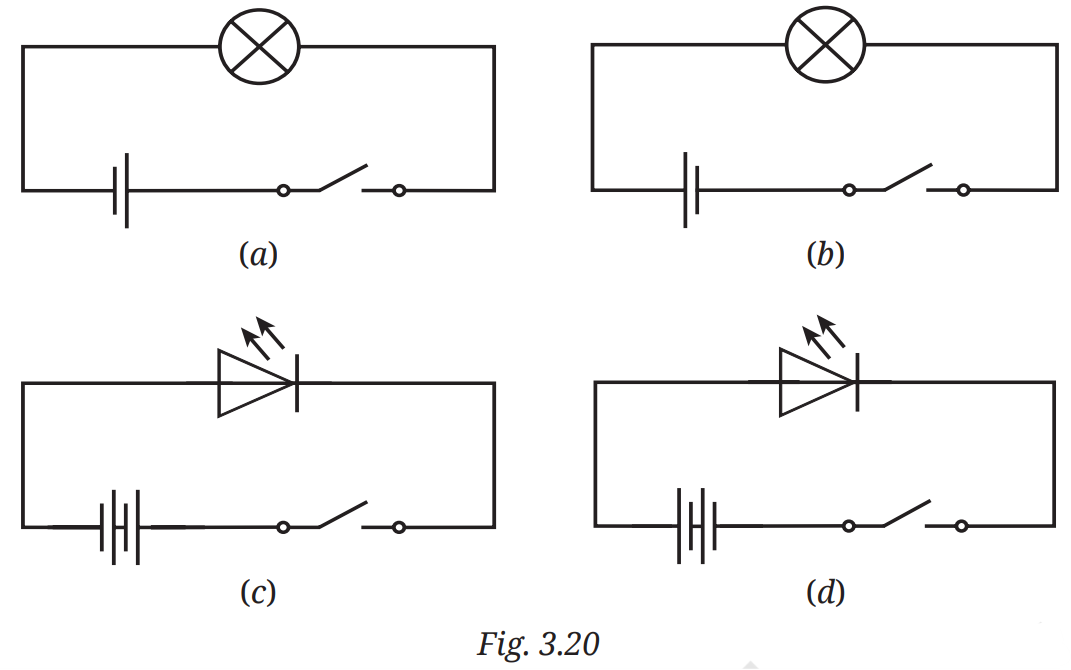
Answer:
Cases (a), (b), and (d) will light up when the switch is closed but case (c) will not light up because the battery's negative terminal is connected to the LED's positive terminal, which means that it is reverse-connected. In this case, current will not flow through the LED and it will not light up.
9. Suppose the ‘+’ and ‘–’ symbols cannot be read on a battery. Suggest a method to identify the two terminals of this battery.
Answer:
We can test the ' + ' and ' - ' of a battery by connecting it to an LED. We know that the longer wire of an LED is the positive terminal of the LED and the shorter wire of the LED is the negative terminal. After connecting the LED to the cell if the LED glows then the terminal connected to the longer side of the LED is the positive terminal of the Cell and the other side is the negative terminal of the cell.
If the LED does not glow after connecting with the cell then exchange the connection of the terminal and test again.
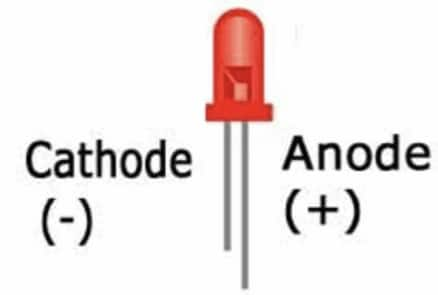
10. You are given six cells marked A, B, C, D, E, and F. Some of these are working and some are not. Design an activity to identify which of them are working. (i) List the items that you require. (ii) Write the procedure that you will follow. (iii) With the items, carry out the activity to identify the cells that are working.
Answer:
i.) To test which of the batteries is working, we will require a working bulb and connecting wires.
ii.) We will connect each of the batteries with the bulb using the connecting wires and check if the bulb glows or not.
iii.) First, we will connect the connecting wires to the terminals of the bulb. Then we will connect the cells one by one to the wires. The bulb will glow in some cases and in some cases it will not. The cells that are able to glow the bulb are identified as working.
11. An LED requires two cells in series to glow. Tanya made the circuit as shown in Fig. 3.21. Will the lamp glow? If not, draw the wires for correct connections.
Answer:
No, the LED will not glow if the cells are not connected in the correct polarity. To make the LED glow, the positive terminal of the battery should be connected to the positive terminal of the LED (longer wire), and the negative terminal of the battery should be connected to the negative terminal of the LED (shorter wire).
Corrected connection:

1. Suppose that due to some problem, the power supply is disrupted in your area for two days. List out which actions from your daily life you would not be able to do.
Answer:
If there is no electricity in my area for two days, many of my daily activities will be affected. Some things I won’t be able to do are:
Switch on lights – I will not be able to study or see things properly at night.
Use fans or AC – It will be very hot and uncomfortable, especially during summer.
Keep food fresh – The fridge will not work, so milk, fruits, and vegetables may get spoiled.
Charge my mobile phone or tablet – I won’t be able to call anyone or attend online classes.
Watch TV or use a computer – I will miss my favorite shows and won’t be able to use the internet.
Cook using electric appliances – I cannot use the microwave, toaster, or induction stove.
Pump water – If the water pump doesn't work, we may run out of water.
Iron clothes – My school uniform may remain wrinkled.
2. Using a solar panel (Fig. 3.22a) as a source of electrical energy, make a circuit to run a toy fan (Fig. 3.22b) as shown in Fig. 3.22c.

Answer:
3. Visit an electrical items shop. With the help of the shopkeeper, identify the various types of cells available. For each cell, also find out which device(s) it is used for. Prepare a report.
Answer:
Visit Date: [Write a date]
Place: [Name of shop]
Accompanied by: Shopkeeper [Mr./Ms. Name]
Introduction:
I visited a local electrical supplies store to learn about the types of cells (batteries) that are used in everyday things. The shopkeeper assisted in my questioning of how I could tell the difference of the types of cells currently available and insisted in noting the types of cells and the appliances they are used for.

Conclusion:
This visit made me aware of and understand the different types of cells and their importance in the operation of a range of electrical appliances. Some are single-use (disposable) while some can be recharged and reused - which is better for our environment!
3. Prepare a list of objects in your home under three categories:
(i) Objects which are electrical insulators only
(ii) Objects which are electrical conductors only
(iii) Objects which are made of both, whose some parts are insulators and some electrical conductors
Answer:
(i) Objects that only act as Electrical Insulators:
These objects do not conduct electricity through them:
(ii) Objects that only act as Electrical Conductors:
These objects conduct electricity through them easily:
(iii) Objects that contain both Conductors and Insulators:
These objects are combination of both ( conductor and insulator parts)
Electricity: Circuits and Their Components in Class 7 Science teaches students the concepts of electric circuits such as the flow of electricity through a circuit and the parts that it requires to complete a circuit. Subsequently, this chapter develops background knowledge about electricity and its practical applications in day-to-day life.
3.1 A Torchlight
3.2 A Simple Electrical Circuit
3.2.1 Electric cell
3.2.2 Battery
3.2.3 Electric lamp
3.2.4 Making an electric lamp glow using an electric cell or battery
3.2.5 An electrical circuit
3.2.6 Electric switch
3.3 Circuit Diagrams
3.4 Electrical Conductors and Insulators
In order to solve Chapter 3: Electricity Circuits and their Components, Class 7 Science, read the chapter to learn simple terms such as electric circuits, cells, switches, conductors, and insulators. Concentrate on the operation of a circuit, how the current moves between the positive and the negative pole of a cell and how a switch is used to operate the current. Find out how to recognize and reproduce basic circuit diagrams having components such as bulbs, wires and switches. Apply the Concepts to everyday life e.g. the use of batteries to operate a torch or why rubber is insulated. Revise the NCERT questions and definitions, and do simple activities where possible, such as testing various materials to determine whether they conduct or not. Regularly revise with diagrams.
In addition to the Class 7 Science chapter 3 question answer, students can access comprehensive chapter-wise solutions for Class 7 Science by clicking the link provided below:
Lights, fans, TVs, refrigerators and lots of appliances are powered by electricity, thus making our life more comfortable.
The filament of a bulb heats and emits light when the electric current is applied through the bulb in a closed circuit through which the electric current flows.
A switch is used to open or close an electric circuit. It controls the flow of electricity. When the switch is closed (ON), the circuit is complete, and current flows; when it's open (OFF), the current stops.
Plastic is insulating material, which barricades electric shocks by not allowing supply of current out of the wire.
The reason is due to the fact that electricity may lead to electric shocks, burns or even fires if electrical devices are handled carelessly.

Take Aakash iACST and get instant scholarship on coaching programs.

This ebook serves as a valuable study guide for NEET 2025 exam.

This e-book offers NEET PYQ and serves as an indispensable NEET study material.

As per latest syllabus. Physics formulas, equations, & laws of class 11 & 12th chapters
As per latest syllabus. Chemistry formulas, equations, & laws of class 11 & 12th chapters
As per latest 2024 syllabus. Study 40% syllabus and score upto 100% marks in JEE